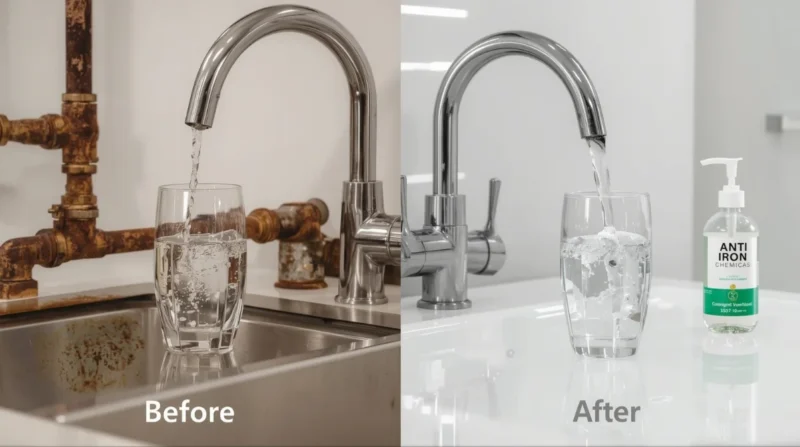Table of Contents
Anti-iron chemicals are vital for managing iron problems in water systems. Whether in a home, well, or industrial setting, iron in water can cause brown or orange stains on plumbing fixtures and laundry, clog pipes, and damage appliances over time. Using specialized chemicals helps keep iron dissolved or converts it into forms that can be filtered, keeping your water clear, stain-free, and safe.
Why Iron in Water Can Be a Problem?
Most iron in water is in the form of ferrous iron (Fe²⁺), which dissolves and looks clear until it hits oxygen and turns into ferric iron (Fe³⁺) the reddish-brown rust people notice. This can:
- Create rust stains on sinks, toilets, and clothes.
- Clog pipes, nozzles, and showerheads.
- Damage water heaters, dishwashers, and boilers.
- Affect the taste, clarity, and smell of water.
Anti-iron chemicals help prevent all these issues by either keeping iron invisible and dissolved or turning it into particles that can be filtered out.
How Anti-Iron Chemicals Work?
There are two main ways these chemicals work.
1. Sequestration (Binding Iron)
Some chemicals, known as sequestrants, bind to iron ions and keep them dissolved so they don’t form rust or scale. Common types include.
- Polyphosphates and phosphonates: Often used in household and industrial systems.
- Citric acid blends: Safe for kitchens and mild iron problems.
Sequestrants are best for cases where iron levels are fairly low (typically under 2 ppm), preventing stains and corrosion without needing filtration.
2. Oxidation + Filtration
When iron levels are high, a two-step process works better.
- Oxidizers like chlorine or hydrogen peroxide convert dissolved iron into solid rust particles.
- Filters such as sand, greensand, and catalytic carbon then remove those particles.
This method effectively handles well water and other systems with significant iron contamination.
Common Uses of Anti-Iron Chemicals
Homes and Apartments: Prevents stains on sinks, tubs, and clothes and reduces scale in appliances.
- Well-Water Systems: Most wells contain iron and manganese adding these chemicals keeps the water usable.
- Industrial Systems: Boilers, cooling towers, and heat exchangers use them to prevent rust and reduce maintenance.
- Irrigation Systems: Cleaner water means healthier plants and no clogged drip nozzles.
Typical Treatment Options
| Method | How It Works | Best For |
|---|---|---|
| Polyphosphates/phosphonates | Bind iron to prevent rust | Low iron (<2 ppm) systems |
| Citric-acid sequestrants | Food-safe iron binding | Kitchens and mild basement issues |
| Oxidizer + filter (greensand/sand) | Rust forms, then filtered | Moderate to high iron levels |
| Air-injection filters | Use oxygen to oxidize iron | Chemical-free alternative |
| KDF / catalytic carbon filters | Remove iron via redox and filtration | Chlorinated or municipal sources |
| Combo systems | Mix sequestration and filters | Best overall for home wells |
Benefits of Using Anti-Iron Chemicals
- No more orange-brown stains on laundry, sinks, or tubs.
- Fewer clogs and better water flow in pipes and nozzles.
- Longer appliance life and fewer frequent repairs.
- Tastier, clearer, more appealing water.
- Reduced home maintenance and improved system longevity.
How to Use Them Safely?
- Start With Water Testing: Check iron levels, pH, and hardness.
- Pick the Right Method: Sequestrant for low levels, oxidation + filtration for higher.
- Follow Dosage Instructions: Avoid side effects like a strange taste.
- Wear Protective Gear: Use gloves and goggles when handling oxidizers.
- Stay Legal: Ensure chemicals are approved for drinking water.
- Maintain Systems: Clean filters and refill chemicals on schedule.
- Retest Regularly: Water should be checked every few months.
Common Challenges
- Strong oxidizers may change the taste if overdosed.
- Filter media can clog without regular care.
- High levels of iron require robust systems.
- Chlorinated water may foul certain filters.
- Some chemicals have discharge restrictions.
Alternatives and Additions
- Water Softeners With Iron Resin: Effective for low iron removal.
- KDF or Catalytic Filters: Great for municipal water with chlorine.
- Aeration or Solar Filters: Use natural oxidation, no chemicals needed.
- Reverse Osmosis or Ultrafiltration: Remove nearly all iron and minerals.
Each has its trade-offs in cost, maintenance, and effectiveness.
FAQ
Q1. Can a water softener remove iron?
Yes, but only small amounts (under 2 ppm). High iron can damage the resin and reduce performance.
Q2. What are greensand filters?
Filters made with manganese-coated sand that oxidizes and captures iron particles. They need occasional regeneration.
Q3. Is oxidizer treatment safe for drinking water?
Yes, when used as directed. Chlorine and hydrogen peroxide are common, but must be dissolved and removed before use.
Q4. How often should filters be serviced?
Backwashing is usually needed every few weeks; media often needs replacement every 5–7 years, depending on use.
Q5. What if I see light staining only?
A sequestrant may be enough to prevent stains without needing full filtration; it keeps iron dissolved and out of view.
Conclusion
Anti-iron chemicals offer an effective, adaptable solution to iron issues in diverse water systems from household taps to industrial boilers. Whether keeping iron in solution or converting it for filtration, they ensure clearer, stain-free, and better functioning water systems. Choose the right method, watch your conditions, and maintain your setup to enjoy clean water and protected infrastructure.









